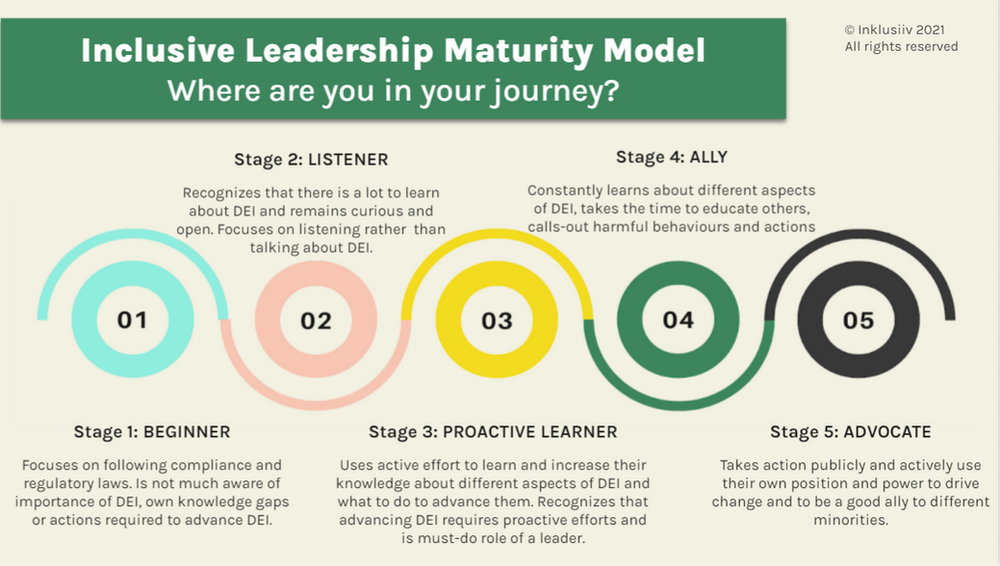Inclusive leadership has been taking the business world by storm; just by googling the phrase, you will encounter over 352 000 000 results. And with a good reason. According to Accenture research, 68 percent of leaders feel they create empowering environments but just 36 percent of employees agree. What leaders say and do makes up to a 70% difference as to whether an individual reported feeling included. But what are the do’s & don’ts of inclusive leadership?
It’s no surprise that Inklusiiv’s June event was the most popular Inklusiiv Talks so far. The largest audience to date turned in to hear what President of the Finnish Athletics Sami Itani, Google’s Yacine Samb and Inklusiiv’s Yesmith Sánchez had to say about inclusive leadership.
In this blog, we’re presenting some of the key learnings from the event, based on Inklusiiv’s very own maturity model.
Where are you in your DEI journey?

Inklusiiv’s Leadership Maturity Model was developed by the Inklusiiv team in 2021. In short, the model acts as a framework for organizations and leaders to help them self-assess their current state in diversity, equity and inclusion (DEI) actions, and help them find the best route forward.
Our model is divided into five different main stages; beginner, listener, proactive learner, ally and advocate. Every stage is defined by the actions organizations and leaders do to improve DEI in their teams. It should be noted that inclusive leadership is a journey – as is everything with DEI – thus the stages can overlap and even jump back and forth. The model provides all organizations and leaders with a framework and a good understanding of what the journey to a more diverse, equitable and inclusive organization can look like.
Inclusive leadership: the do’s and don’ts
Don’t hire for culture fits, Do hire for culture adds
Often you hear about organizations looking to hire culture fits and organizations might even, so proud of their organizational culture, openly look for them. Culture fits are people that embody what is already working in an organization and might even be the people you’d like to have as friends. The obvious pitfall for culture fit hiring is that it embodies affinity bias – hiring like-minded people is more comfortable for any organization. This mindset can be exclusionary and might, even if unconsciously, reinforce prejudice. Instead of focusing on culture fits, organizations should put more weight on culture adds.
Culture adds are about bringing new and helpful voices, experiences and perspectives into your organization. Hiring culture adds increases the inclusivity in your team and can create a new mindset into the organization. Also, remember that hiring a cultural add is not about ticking a “diversity box”.
The obvious pitfall for culture fit hiring is that it embodies affinity bias – hiring like-minded people is more comfortable for any organization.
Don’t have one-sided feedback, Do Feedback cycles
It’s surprising how undermined the importance of two-way feedback can be. One of the most important traits of inclusive leadership is to proactively ask for and give feedback. Instead of one-sided, top-down feedback with little or no real interaction between the leader and the team member, we encourage all leaders to focus on listening but also on asking questions. Direct and personalized feedback also helps to avoid unnecessary stereotyping by leaders.
Harvard Business Review’s research shows that when leaders ask for feedback and talk openly about their own weaknesses, team members feel more included. Humility encourages sharing feedback and have honest, inclusive feedback conversations instead of one-sided speeches. Interpersonal and inclusive feedback discussions create a sense of personal connection between the leader and the team member, making working together easier.
Don’t strengthen stereotypes, Do Break down assumptions
One of the most important traits generating a sense of inclusiveness is a leader’s visible awareness of biases – of their own and of the organizations. Furthermore, team members want to see that their leaders are determined to address and overcome their biases. With stereotyping – meaning having a fixed, over-generalized belief about a particular group or class of people – this awareness is crucial.
Breaking stereotypes can be started by simply having honest conversations about stereotypes and what they mean in the workplace. It might be uncomfortable at first but crucial to advance inclusion in the workplace. Bringing the cat to the table is a healthy way to start breaking down biases in a natural, non-confrontational way. Another tool for breaking down harmful stereotypes is the mindful use of your language. We encourage leaders to learn more about their own biases so they can become aware of how these affect the decisions they make. One helpful way to know more about the topic is for example to take part in unconscious bias trainings.
Breaking stereotypes can be started by simply having honest conversations about stereotypes and what they mean in the workplace.
Don’t Overlook surveys, Do Create metrics and follow them
You can’t manage if you can’t measure. A big pitfall for any leader is not to actively craft and follow tangible metrics on diversity and inclusion. Data and surveys can be useful in measuring and identifying biases, challenges and opportunities within organizations. Luckily, Inklusiiv can help.
But don’t be fooled – simply gathering data isn’t enough, unless it can be turned into insights that can help leaders take the right actions to create impact. The first step of any data gathering is to identify the purpose of the information – why are you gathering this data, and how are you going to use it? What are you hoping to achieve? These questions – as hard as they can be – will guide leaders in the right direction. We’ve covered data-driven DEI before more in-depth in our previous blog.
About Inklusiiv
At Inklusiiv, we believe that inclusive leadership is being acknowledged more and more as a significant skill to help organizations adapt to a diverse range of customers, markets, ideas and talent. Inclusivity will not only enhance your internal team environment but also elevate and help you to reach your business goals. In the following months, expect more inclusive leadership themed blogs from us.

Did you miss the June’s Inklusiiv Talks on Inclusive Leadership? No worries! You can watch the streaming of the event here.

